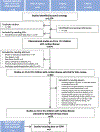Extracorporeal Cardiopulmonary Resuscitation Use Among Children With Cardiac Disease in the ICU: A Meta-Analysis and Meta-Regression of Data Through March 2024
- PMID: 39177428
- PMCID: PMC11449666
- DOI: 10.1097/PCC.0000000000003594
Extracorporeal Cardiopulmonary Resuscitation Use Among Children With Cardiac Disease in the ICU: A Meta-Analysis and Meta-Regression of Data Through March 2024
Abstract
Objective: Epidemiologic data on extracorporeal cardiopulmonary resuscitation (ECPR) use in children with cardiac disease after in-hospital cardiac arrest (IHCA) are lacking. We aimed to investigate trends in ECPR use over time in critically ill children with cardiac disease.
Data sources: We performed a secondary analysis of a recent systematic review (PROSPERO CRD42020156247) to investigate trends in ECPR use in children with cardiac disease. PubMed, Web of Science, Embase, and Cumulative Index to Nursing and Allied Health Literature were screened (inception to September 2021). For completeness of this secondary analysis, PubMed was also rescreened (September 2021 to March 2024).
Study selection: Observational studies including epidemiologic data on ECPR use in children with cardiac disease admitted to an ICU.
Data extraction: Data were extracted by two independent investigators. The risk of bias was assessed using the National Heart Lung and Blood Institutes Quality Assessment Tools. Random-effects meta-analysis was used to compute a pooled proportion of subjects undergoing ECPR; meta-regression was used to assess trends in ECPR use over time.
Data synthesis: Of the 2664 studies identified, 9 (17,669 patients) included data on ECPR use in children with cardiac disease. Eight were cohort studies, 1 was a case-control, 8 were retrospective, 1 was prospective, 6 were single-center, and 3 were multicenter. Seven studies were included in the meta-analysis; all were judged of good quality. By meta-analysis, we found that a pooled proportion of 21% (95% CI, 15-29%) of pediatric patients with cardiac disease experiencing IHCA were supported with ECPR. By meta-regression adjusted for category of patients (surgical vs. general cardiac), we found that the use of ECPR in critically ill children with cardiac disease significantly increased over time ( p = 0 .026).
Conclusions: About one-fifth of critically ill pediatric cardiac patients experiencing IHCA were supported with ECPR, and its use significantly increased over time. This may partially explain the increased trends in survival demonstrated for this population.
Copyright © 2024 by the Society of Critical Care Medicine and the World Federation of Pediatric Intensive and Critical Care Societies.
Conflict of interest statement
Dr. Alexander is Treasurer and serves on the Board of Directors of the Extracorporeal Life Support Organization (ELSO); and the National Institute of Child Health and Human Development (R13HD104432). Drs. Alexander and Thiagarajan: their institution has received funding from the U.S. Department of Defense (Peer Reviewed Medical Research Program Clinical Trial Award Number W81XWH2210301). Dr. Thiagarajan received funding from the Society of Critical Care Medicine and the ELSO. Dr. Maschietto received funding from Edwards Lifesciences and Medtronic. The remaining authors have disclosed that they do not have any potential conflicts of interest.
Figures



References
-
- Stroup DF, Berlin JA, Morton SC, et al. : Meta-analysis of Observational Studies: a proposal for reporting. JAMA 2000; 283:2008–2012 - PubMed
-
- Parra DA, Totapally BR, Zahn E, et al. : Outcome of cardiopulmonary resuscitation in a pediatric cardiac intensive care unit. Crit Care Med 2000; 28:3296–3300 - PubMed
-
- Hansen G, Joffe AR, Nettel-Aguirre A, et al. : Two-year survival and neurodevelopmental outcomes after cardiopulmonary resuscitation in neonatal patients after complex cardiac surgery. Resuscitation 2011; 82:313–318 - PubMed
Publication types
MeSH terms
Grants and funding
LinkOut - more resources
Full Text Sources
Medical

